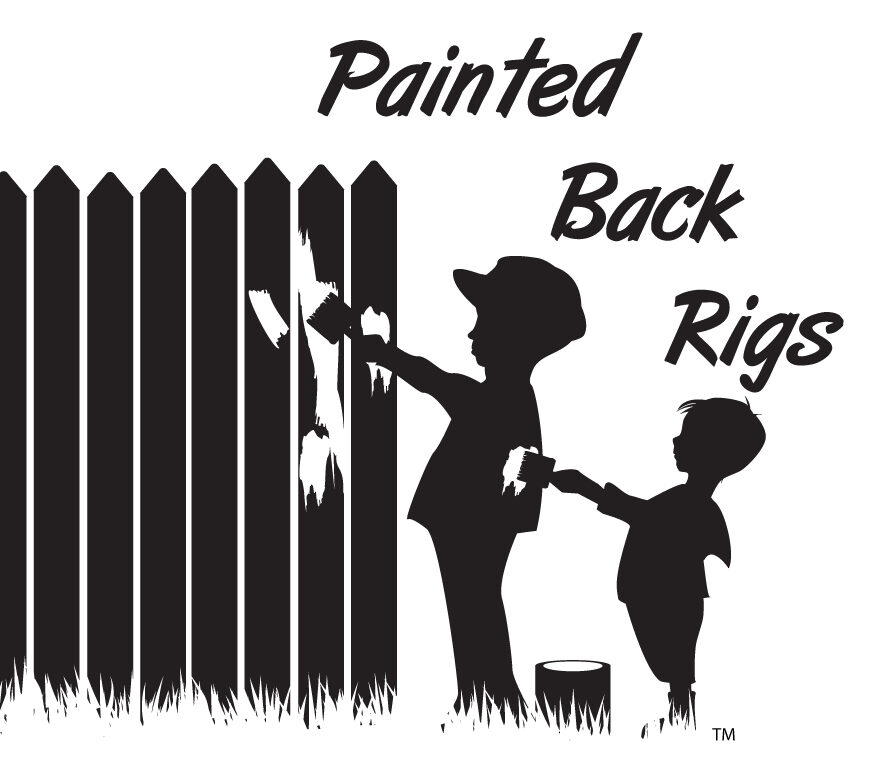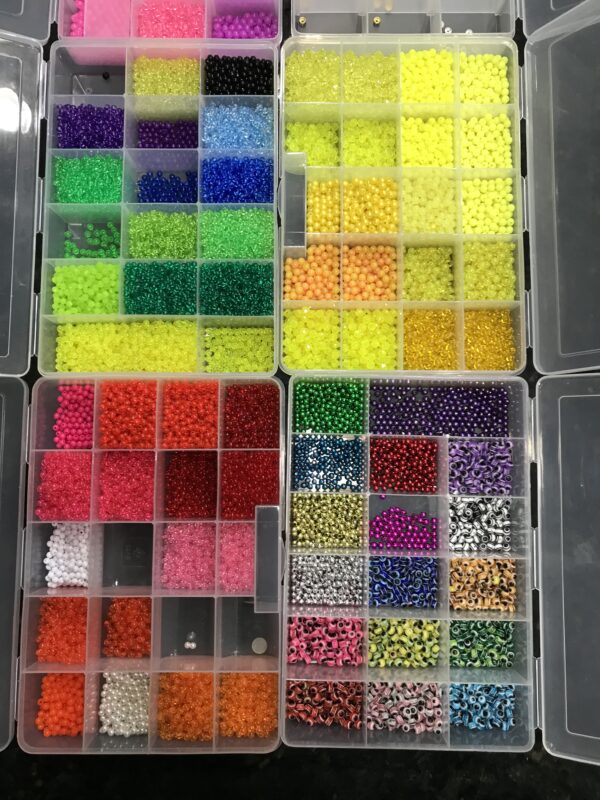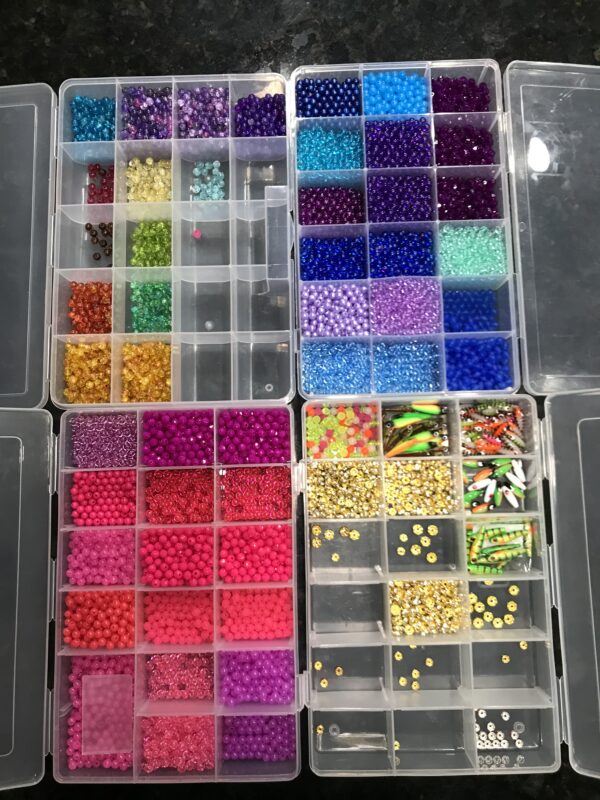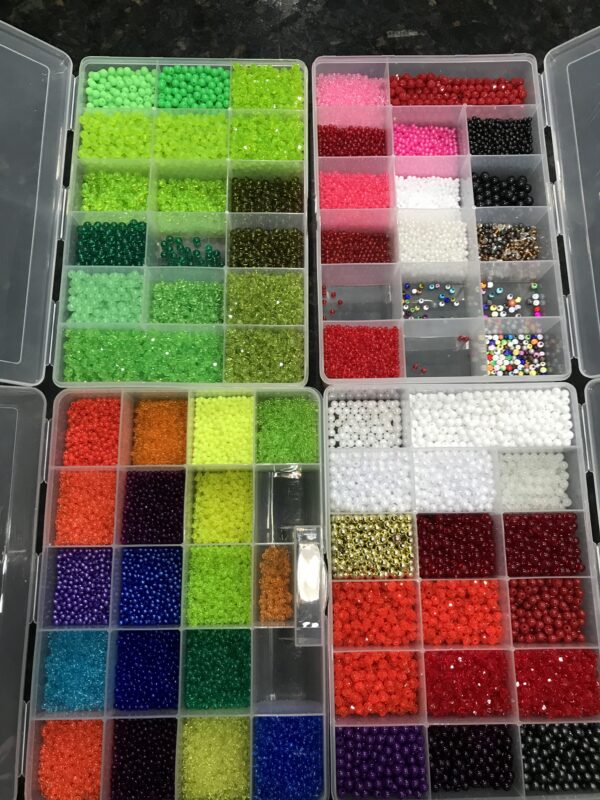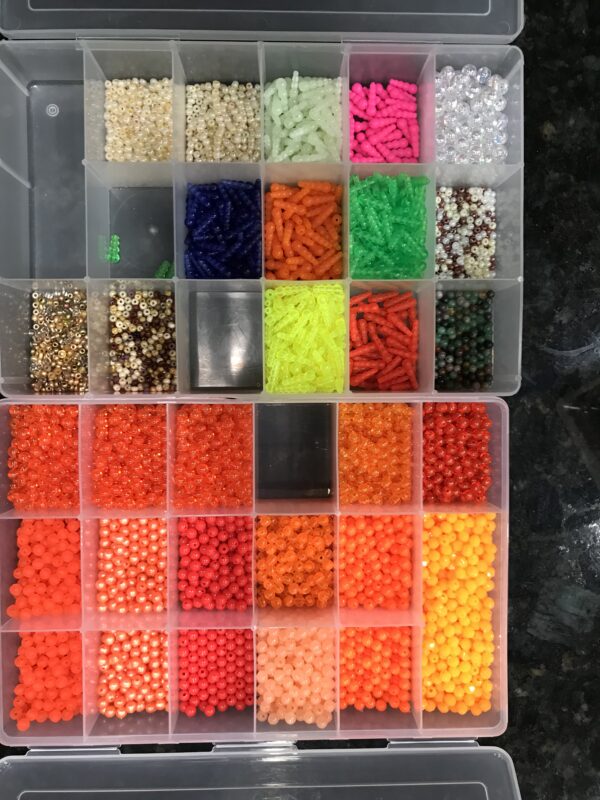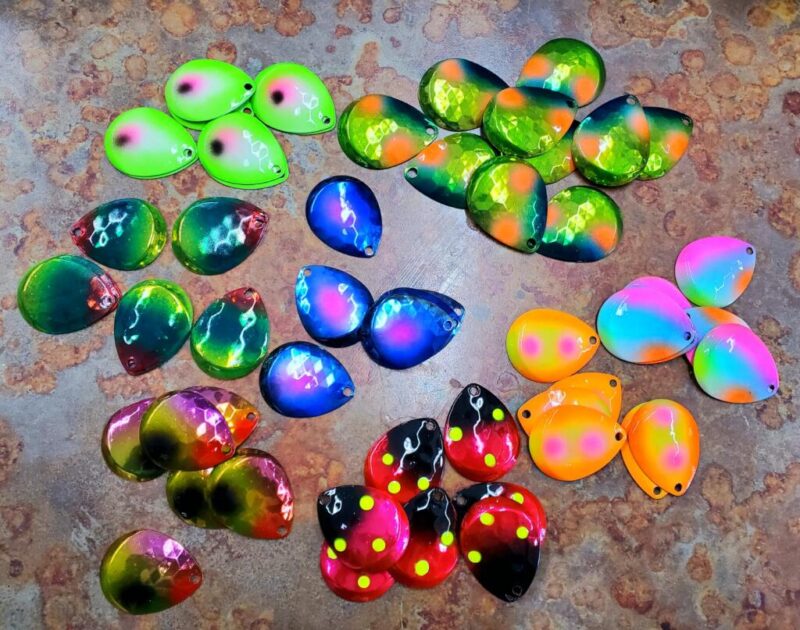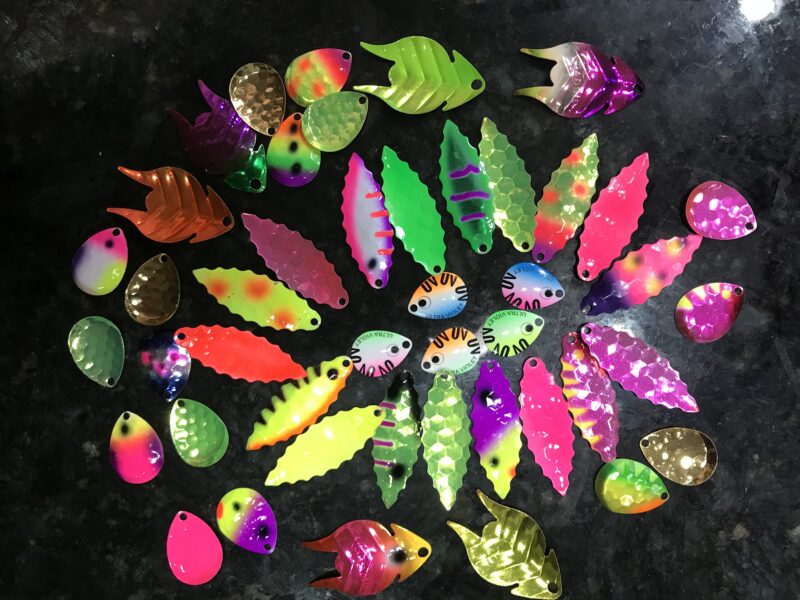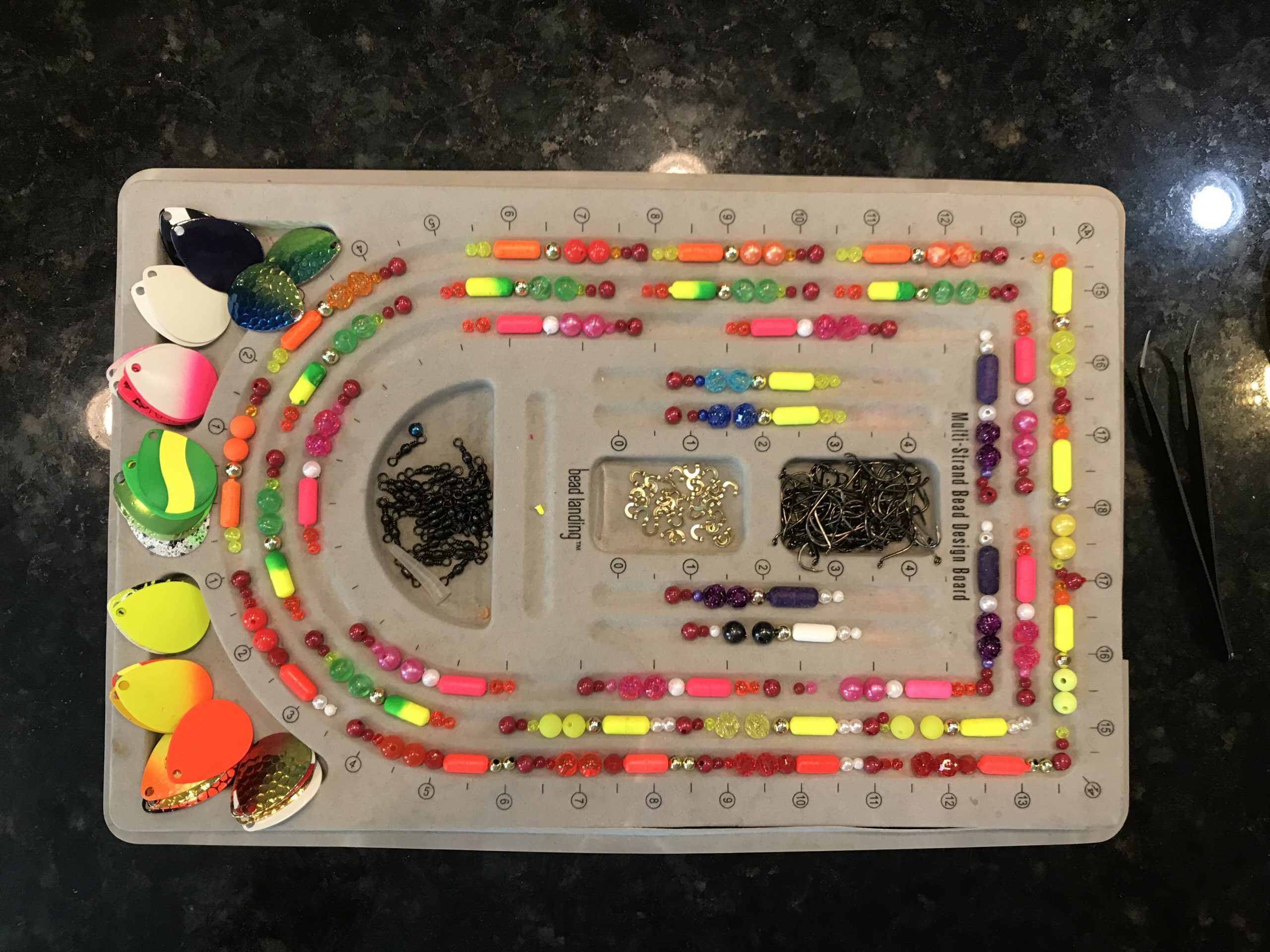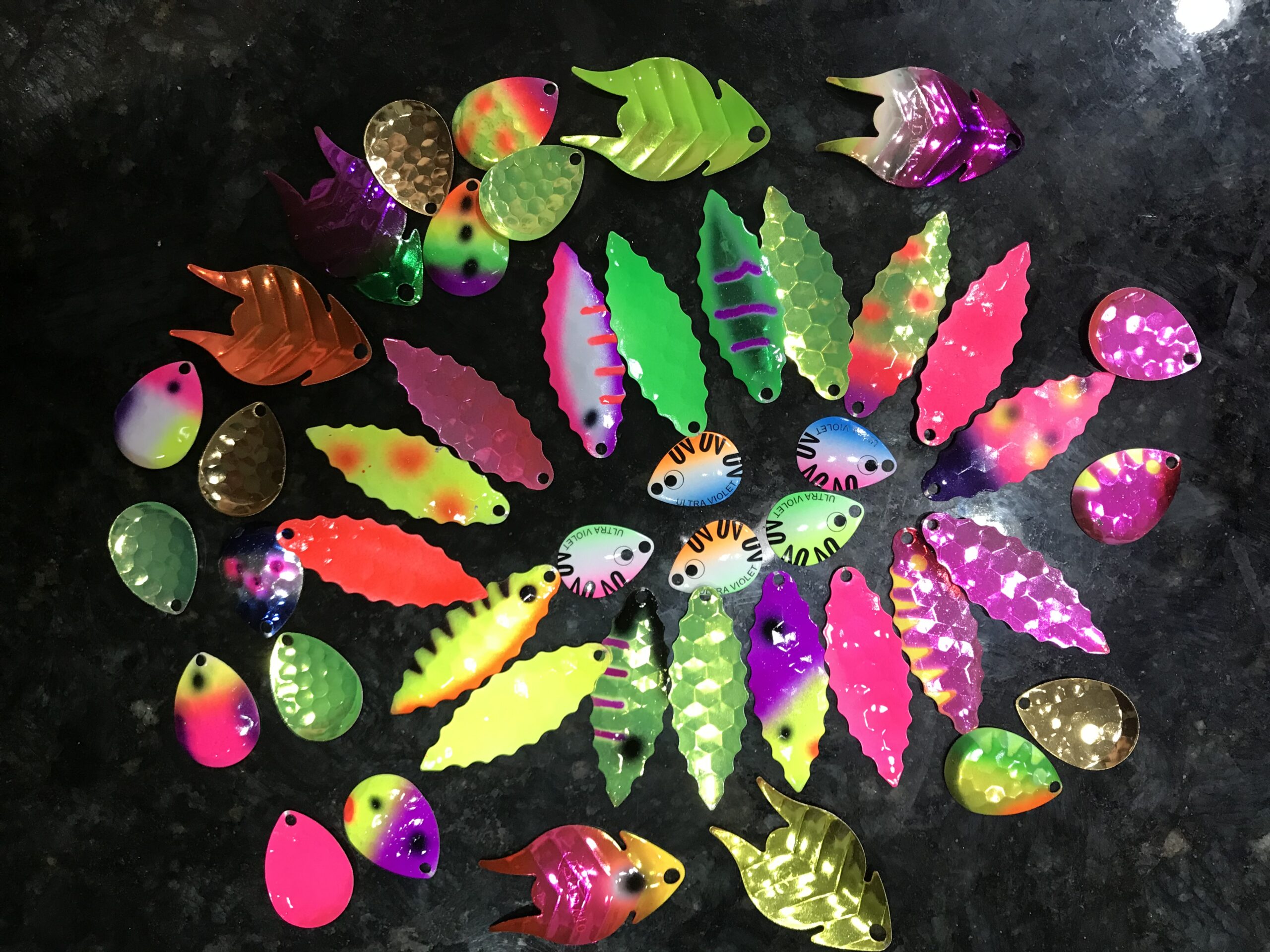
by Norm Ziesman
(This blog was updated on January 25, 2024.)
In part one of this two-part blog I covered my thoughts and learnings on line, knots and hooks. For those that read through the whole blog, hopefully you found the information, or at least some of it, useful in your building or selection of crawler harnesses. In this considerably longer blog, I will cover the rest of the crawler harness components and share with you my thoughts, experiences and recommendations as well as some rules and exceptions to rules I have developed over the thousands of rigs I have created.
We’ll get through the less controversial remaining components first before we tackle the big two – beads and blades.
SWIVEL
Many rig builders tie off their harness with a loop. I think that is just fine and a matter of personal preference. The other option, of course, is to tie off the harness with a swivel. I have always chosen to do that, primarily because I don’t know if the person getting my rig has a suitable swivel in their tackle box. Many do but some do not. So, I really do it as a matter of convenience.
It does lead to a debate on what to attach it to on your main line. A swivel attached to a snap swivel is certainly not needed so, it would logically just have to be attached to a plain snap.
One thing I do like about the swivel is that I tie it with a Palomar knot which puts the line through the swivel eye twice, giving you two points to spread the stress over and avoiding a single “stress point” or possible point of failure taking all the stress.
As far as types of swivels, most agree that ball bearing swivels are the tops and preferred swivels followed by crane and then barrel swivels. They are also priced accordingly. So, if you are making just a few for yourself, go for the best. If you are going to be producing hundreds or thousands, then budget is a consideration. They all work fine – it is just a matter of affordability and where you want to spend your money. In bulk, ball bearing swivels are around 10 times more expensive than barrel and crane swivels.
Size wise – I go with 30 – 35 lb test swivels for most rigs with size 4 blades and smaller. For rigs with larger blades, I will step up one size in swivel (usually around 75 lb test).
As far as color is concerned, I prefer black swivels over brass or nickel. However, black is usually priced slightly higher than brass or nickel as well. To be truthful, I go back and forth between black and brass, but I still prefer black. It is your call.
If you are tying a loop, then make sure you choose a knot where the knot holds in place and does not slide up.
CLEVIS
There are four types of clevises – quick change, stirrup, folded and clip–n-spin. In quick change clevises, there are three types – regular (original with no blade keeper barb), improved ones with a “ blade keeper barb” and those made by Dutch Fork.
First up, do NOT buy or use stirrup clevises. They are for wire-based spinners, not fishing-line-based spinners.
Budget wise, folded clevises are the way to go.
If you like the quick change concept, then go with the Dutch Fork design for optimum performance. If you don’t like those and prefer the standard quick change clevises, get ones with a blade keeper barb on them. The Clip ‘N’ Spin clevis also works well for the quick blade change concept and, like the Dutch Fork, does a better job of keeping the blade from flying off.
If you go with folded clevises, you need to know two important things – how to shop for size and color choice.
Color choices are nickel, brass or black. I always buy brass folded clevises. I have no justification for this other than I like to have a hint of gold in every harness.
Secondly, different vendors quote their sizes differently. So watch out. What Hagens calls size 0, 1, 2 and 3 are respectively called size 1, 2, 4 and 6 at other vendors such as Walleye Supply. It took me a long time to figure that out. Make sure you know what you are ordering.
In the summer of 2023, I switched over to Clip ‘N’ Spin clevises totally (size 2) – the one size works for all the blades I use. This was primarily due to customer demand by tournament fishermen.
FLOATS
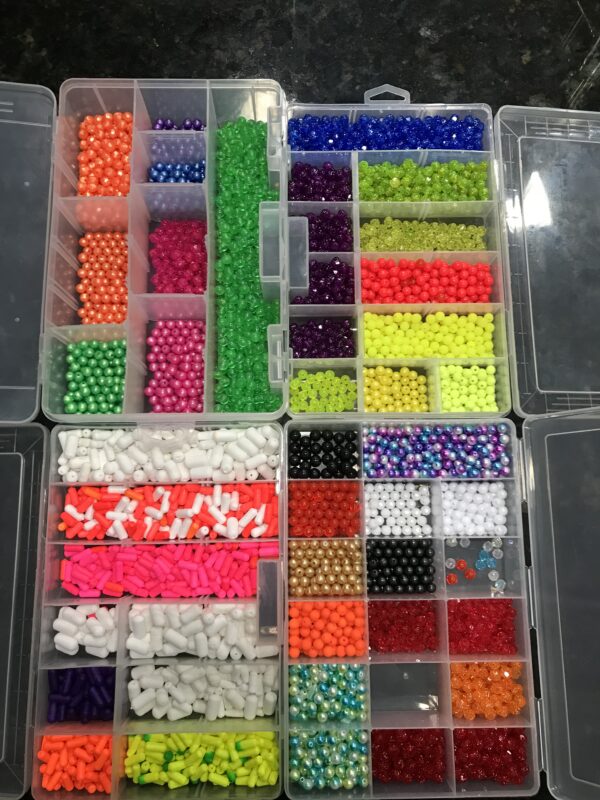
Floats and Beads
When I first started making spinner rigs, I think I had one float on every harness mixed in with the beads. I realized most experienced crawler harness fishermen were making, buying and using harnesses without them. Particularly those fishing big water such as Lake Erie.
Consider using floats when your target fishing area has lots of snags. Put one or even two floats on each rig. If you are fishing down 30 feet in 70 feet of water – no float is needed. Most rigs I now make have no floats on them but I regularly carry a couple with the torpedo-shaped floats (not shown).
Colors, shapes and sizes of floats provide plentiful choices but my preference is for the pill-shaped or torpedo-shaped floats in medium or large size. If you are going the route of using floats, you will want to spend a little money to build up an inventory of color choices.
BEADS
One of the debates from over 20 years ago on walleyecentral.com was about which was more important – the blade or the beads. I think the audience on that particular chat stream was pretty much split. I prefer to think of the rig or harness as a whole. I happen to believe it is the combined impression of the beads and the blade working together that generate the reaction by the fish – not one or the other. So, if you think that makes sense, don’t ignore this section – it can make a huge difference in how productive your rigs are.
Some harness makers like to keep their bead choices simple. I envy those of you that do. If all you use is 5 mm transparent orange beads with your gold only blades, and that is all you want to use, you can skip this lengthy section. (There are some that do.)
If you are going into it in a big way and plan on building your bead inventory, just start at beadtin.com. It is the least expensive place I have found to get most of your round and faceted beads in 4 mm, 5 mm and 6 mm. They also have 8 mm and stacked beads if you want. They don’t have every color but they will have more color choices than most vendors. However, check out other vendors for additional colors, shades, hues and shapes. I found shopping on eBay and Amazon productive for wedding ring beads (“spacers”), eyeball beads and metallic beads. While I did pick up some beads at the craft stores, these are my preferred vendors these days. There are also “fishing beads” to consider – always more expensive – and their feature is a smaller diameter hole which is intended to reduce wobble or wear I suppose. They are usually only available in round beads and in limited color choices and sizes.
Over time, I have found a preference to do the following in my bead selection, any and all of which you may wish to consider and choose to ignore:
- Try as much as possible to match or complement the blade colors with your bead color choices.
- Try to have a hint of gold in the beads somewhere. I use a gold (not silver) wedding ring bead or a gold metallic bead. I only use silver in place of gold if blue or silver is the dominant color on the blade. Generally, this is because, where I fish for walleye, gold is one of the top producing colors. If you choose to use wedding ring beads, match the size of the wedding ring bead to the size of the other beads on each side of it. In other words, use a 6 mm wedding ring spacer bead between two 6 mm beads. If you don’t do this, it will look awkward. Also, if you choose to use wedding ring beads, don’t be afraid to give some design thought to using two wedding ring beads in the pattern rather than just one. After all, isn’t a “double ring ceremony” pretty much a thing now?
- Don’t be afraid to use faceted rather than round beads or even mix the two. It adds to the disturbance in the water to grab the attention of the fish – however minor.
- Whenever possible, I prefer to use transparent beads rather than opaque. Initially, when I started making rigs, I avoided them because I thought they were too light in color compared to the opaque beads. However, after doing some more research, I reversed my thinking on this design consideration. I found a few articles that were by authors that felt using transparent beads created more flash in the water because of how they refracted light. And that was the line of reasoning that worked on me to change my design considerations at the time. So, it may change yours as well when you stop to consider it.
- I put a 4 mm bead in front and behind each clevis. This was to enable the clevis to spin free without getting caught in the hole of a larger bead. I saw this being done on a number of tandem rigs being used on Lake Erie and stuck with it.
- In addition to the 4 mm bead in front of the clevis, always have a leading bead in front of the 4 mm bead that is to serve as the “eye” bead. I started out in all my early rigs with this being a 6 mm or 8 mm ruby red bead. Later I modified my choices to include eyeball beads and other dark shade or even black beads as options for the “eye” bead. Why an “eye” bead? The argument for it is one I got off of a couple of YouTube videos from two different rig makers – both recommending it as an addition to any rig to keep the clevis free of “junk” such as algae in the water and therefore able to spin freer longer. There are others that believe this leading bead interferes with the clevis’s ability to spin freely but I have no observation, analysis or opinion on this one way or the other. I just always include one. As a rule, I use a plain dark colored bead rather than an eyeball bead for the “eye” bead if there is already an eye on the blade. No sense having an eyeball in front of an eyeball. I will also from time to time, break my rule of the bead having to be dark and now work the color selection more into the overall bead pattern rather than sticking to a rule that “it must be dark”. Although I prefer to always have the leading bead, there is nothing to say that you cannot go without. And if you buy a harness with beads in front of the clevis and don’t like it, just remove them and retie the harness. The bonus of the extra bead(s) is in the added flexibility it gives you in color combinations and bead sequence designs.
- I have and use stack beads and minnow beads and am intrigued with the additional choices they provide in design and configuration. Here again cost is a consideration if producing harnesses in bulk. So far, I have not found a source for a good transparent purple stack bead – no idea why. I am beginning to suspect nobody makes them. I have limited my use of stack beads due to their cost but I do really like them in designs where I want a tapered effect either leading or trailing or both. On stack beads, if you managed your bead acquisition well, you should have a 4 mm, 5 mm and 6 mm bead of some of your main color choices. If you did that, you can configure your own leading or trailing “short stack” without having to use the longer stack bead. It won’t have the size 3.5 and 3 mm bead but it will serve the purpose just fine. Also, I am finding a small number of my stack beads have their 3 mm part broken off just from shipping and handling. So, I question their durability on their small end. If you really like using stack beads, most vendors have just single color stack beads but if you check out Walleye Supply, you’ll find multi-color stack beads to give you even more design options to consider. You’ll also find two different models of minnow beads.
- # of beads – Choose the length of your bead pattern to be at least the length of your blade (usually 5 or 6 beads). You don’t want your blade spinning and knocking your bait off your hook and doing this will prevent that. How many you actually use is up to you. I generally will do 5 – 7 beads not counting the 4 mm bead after the clevis and the wedding ring bead. Sometimes 8.
- Bead patterns – many fishermen consider their bead color pattern to be their most closely guarded secret. In my case, they are all available for anyone to see on the paintedbackrigs.com website so I have no secret patterns. Everything I have come up with or copied is out on the site. You are welcome to peruse them all and pick the ones you like. Or, better yet, just buy them. This is one of the most fun parts of creating your own harnesses.
- Bead size – stick with 4 mm, 5 mm and 6 mm for the most part. If you are making large rigs (size 6 and up) then you can go with 8 mm beads but you can also stick with 6 mm if you don’t want all those extra large beads hanging around in your inventory.
- Metallic beads – have them and use them for some color choices.
- Glow beads – have some in different colors in your inventory and you’ll have even more to consider in creating harnesses for low-light conditions.
- Glass beads – I really like them for light refraction. I have greatly increased my inventory in them over the past 3 years and frequently use them in the harnesses I now make. They are a step up in quality from plastic beads but only the connoisseurs of crawler harness making really appreciate their added fish-attracting capabilities. They also cost more and weigh more than plastic beads – two additional considerations. You will have to shop around with various vendors to build your inventory choices up to match your blade color combinations.
BLADES
I will just get this out of the way to start with. I have no experience nor do I use Smile, Dakota, Tomahawk, Whip Tail, Cascade or Spiral spinner blades. I am most familiar with Colorado, Willow Leaf, Arrowhead and Hatchet blades. I have some use and / or make harnesses / rigs with propeller, Dutch Fork, French and Indiana blades.
If you are starting out making your own spinner rigs or starting out shopping for spinner rigs for yourself to use, start with size 4 Colorado blades for slower trolling and size 4.5 or 5 Willow Leaf blades for trolling a little faster. These alone will provide you with an endless variety of sizes and colors to fill your tackle box.
In the world of Colorado spinner blades there are still other things to consider. Deep cup vs regular shape vs magnum. Smooth vs. hammered vs dimpled vs fluted vs those with a hole in them.
In the world of Willow Leaf blades, there are the regular shape and the serrated and super shapes. And they are also either smooth or hammered.
Presuming you are fishing for walleye, start with regular Colorado size 4 smooth blades and go from there. Add to your inventory according to your planned use. Big water, big fish, bigger lures. Perch – smaller lures.
You probably already know or have a good idea as to what colors will work best where you fish for what you are fishing for. Your selection of what spinner rigs / crawler harnesses to buy or make will begin with your thoughts on what color choices you want to have for the blade on the end of your line. Where I fish, the first color choice is gold, followed by an orange/white combo followed by chartreuse. Others I fish with will tell you that pink and multi-color such as the Wonderbread color combo are better for that same water. If none of those are working, out come the antifreeze, purples, blues, greens and reds. Never is silver/chrome a choice to consider where we fish and those lures are forever banished to the bottoms of our tackle boxes. For our group. You get the idea. You want choice but it’s got to be the choice of right choices.
Blades may also have different finishes on them. Ultraviolet and fluorescent blades add more visibility and are a neat option to have in your arsenal. Antifreeze finishes on the back and sometimes also on the front of the blade give you another look to consider. Which leads me to the last thought I think I want to share on this topic. Whether making rigs or buying them – unless you want to have a silver or nickel back on your spinner blade, start with a blade with a painted back. If not one with a painted back, then one with a gold, copper or brass back. Avoid a silver or nickel back. If shopping for blades, unless they tell you or show you the back of the blade color, just assume it is silver or nickel when you make your purchasing decision. Just keep in mind, if the fish is following your harness from behind, it is seeing the color on the back of the spinning blade much more than the front of the blade. For me, of course, I always prefer to start with a Painted Back Rig.
